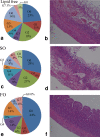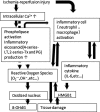Effect of an omega-3 lipid emulsion in reducing oxidative stress in a rat model of intestinal ischemia-reperfusion injury
- PMID: 22907722
- PMCID: PMC3433667
- DOI: 10.1007/s00383-012-3144-0
Effect of an omega-3 lipid emulsion in reducing oxidative stress in a rat model of intestinal ischemia-reperfusion injury
Abstract
Objectives: The usefulness of omega-3 lipid emulsions has been extensively studied. The objectives of the present study were to examine the effect of an omega-3 lipid emulsion in reducing oxidative stress in a rat model of intestinal ischemia-reperfusion injury and the underlying mechanism.
Methods: A total of 66 rats were divided into three dietary groups (lipid-free, soybean oil, and fish oil groups). Each animal was administered total parenteral nutrition for 3 days, followed by induction of intestinal ischemia for 100 min. Animals subjected to sham surgery served as the controls. Intestinal tissue and blood were harvested 6 and 12 h after the surgery, then, assessment of the histological damage score, plasma-related parameters, and statistical evaluation were performed.
Results: The histological damage score in the intestinal tissues was significantly lower in the fish oil group than in the soybean oil group (P = 0.0121). The late-phase urinary level of 8-hydroxy-2-deoxyguanosine was also significantly lower in the fish oil group as compared with that in the other groups (P = 0.0267). Furthermore, the plasma level of high-mobility group box 1 protein was also significantly lower in the fish oil group as compared with that in the lipid-free group (P = 0.0398).
Conclusion: It appeared that intravenous administration of an omega-3 lipid emulsion prior to ischemia-reperfusion injury reduced the oxidative stress and severity of tissue damage. Modification of membrane fatty acids may serve as the mechanism underlying this reduction of tissue damage.
Figures






Similar articles
-
Parenteral nutrition-associated liver injury and increased GRP94 expression prevented by ω-3 fish oil-based lipid emulsion supplementation.J Pediatr Gastroenterol Nutr. 2014 Dec;59(6):708-13. doi: 10.1097/MPG.0000000000000558. J Pediatr Gastroenterol Nutr. 2014. PMID: 25199039 Free PMC article.
-
Dietary omega-3 polyunsaturated fatty acids attenuate hepatic ischemia/reperfusion injury in rats by modulating toll-like receptor recruitment into lipid rafts.Clin Nutr. 2013 Oct;32(5):855-62. doi: 10.1016/j.clnu.2012.11.026. Epub 2013 Jan 23. Clin Nutr. 2013. PMID: 23395256
-
Fish-oil emulsion (omega-3 polyunsaturated fatty acids) attenuates acute lung injury induced by intestinal ischemia-reperfusion through Adenosine 5'-monophosphate-activated protein kinase-sirtuin1 pathway.J Surg Res. 2014 Mar;187(1):252-61. doi: 10.1016/j.jss.2013.10.009. Epub 2013 Oct 12. J Surg Res. 2014. PMID: 24231522
-
Prevention of parenteral nutrition-associated liver disease: role of omega-3 fish oil.Curr Opin Organ Transplant. 2010 Jun;15(3):334-40. doi: 10.1097/mot.0b013e3283394879. Curr Opin Organ Transplant. 2010. PMID: 20503524 Review.
-
Fish oil-based lipid emulsions prevent and reverse parenteral nutrition-associated liver disease: the Boston experience.JPEN J Parenter Enteral Nutr. 2009 Sep-Oct;33(5):541-7. doi: 10.1177/0148607109332773. Epub 2009 Jul 1. JPEN J Parenter Enteral Nutr. 2009. PMID: 19571170 Review.
Cited by
-
MicroRNA-26b-5p Targets DAPK1 to Reduce Intestinal Ischemia/Reperfusion Injury via Inhibition of Intestinal Mucosal Cell Apoptosis.Dig Dis Sci. 2022 May;67(5):1794-1805. doi: 10.1007/s10620-021-06975-7. Epub 2021 Apr 10. Dig Dis Sci. 2022. PMID: 33839982 Free PMC article.
-
The effect of ω-3 polyunsaturated fatty acids on the liver lipidome, proteome and bile acid profile: parenteral versus enteral administration.Sci Rep. 2019 Dec 13;9(1):19097. doi: 10.1038/s41598-019-54225-8. Sci Rep. 2019. PMID: 31836843 Free PMC article.
-
Actors and Factors in the Resolution of Intestinal Inflammation: Lipid Mediators As a New Approach to Therapy in Inflammatory Bowel Diseases.Front Immunol. 2017 Oct 23;8:1331. doi: 10.3389/fimmu.2017.01331. eCollection 2017. Front Immunol. 2017. PMID: 29109724 Free PMC article. Review.
-
The ω-3 Polyunsaturated Fatty Acids and Oxidative Stress in Long-Term Parenteral Nutrition Dependent Adult Patients: Functional Lipidomics Approach.Nutrients. 2020 Aug 6;12(8):2351. doi: 10.3390/nu12082351. Nutrients. 2020. PMID: 32781598 Free PMC article.
-
Dietary supplementation with omega-3 fatty acid attenuates 5-fluorouracil induced mucositis in mice.Lipids Health Dis. 2015 Jun 12;14:54. doi: 10.1186/s12944-015-0052-z. Lipids Health Dis. 2015. PMID: 26063053 Free PMC article.
References
Publication types
MeSH terms
Substances
LinkOut - more resources
Full Text Sources
Other Literature Sources

